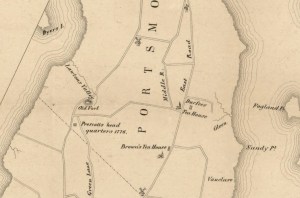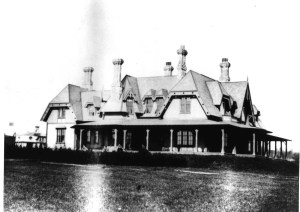Today we might think of “tea houses” as a place to have a quiet cup of tea and sweet snack. Tea houses were quite different in 19th century Portsmouth. They served as hotels, party venues and places for the community to gather for events. I have known about the Durfee Tea House off of Glen Road, but I didn’t know very much about other tea houses in Portsmouth. This week I came across the name “Brown’s Tea House” as I was doing other research, so I dug deeper to find out something more about this tea house.
Researching local history is like piecing a puzzle together. You get one clue from one source and that leads you to bits and pieces of information through other sources. Piecing the information together, you come to understand small windows of Portsmouth life. I’m always searching for old maps and I came across a 1849 Hammett Road Map of Aquidneck Island on the Library of Congress website. The purpose of the map was to show the roads, but it did mark some sites of interest like churches and windmills. Marked by “East Road” were both the Durfee Tea House (off of Glen Road) and Brown’s Tea House.
Through a newspaper database I found an advertisement for a new tea house in Portsmouth in 1847 – “Fashionable Tea House – Five miles from Newport, on the Post Road leading to the Stone Bridge”. Benjamin Brown is the proprietor. They welcome “transient and permanent Boarders” and offer “Tea Parties and Pic Nice furnished at short notice.” Next to the house are two bowling alleys “where those who take pleasure in this invigorating exercise can indulge.” They even had a 20 by 45 foot ballroom.
What happened to the Brown’s Tea House? A later advertisement in 1857 announces a Tea House owned by Charles Russell, Jr. It seems to be in the same location as the Brown Tea House. The ad boasts that Russell has enlarged the house and put it in excellent order. “The location is delightful, and persons visiting the House, for a long or short time, will find every convenience and luxury…there is fine bathing half a mile from the house. Families desiring to spend the summer in the country will find this one of the most delightful locations on the island.” (Newport Daily News 08/06/1857.)
Yet another source, David Durfee Shearman’s diary, adds to the story.
Entry from 12/17/1858 “The Tea House owned by Charles Russell and occupied by him as a tavern was burned to the ground last night… It is supposed to have caught fire from the stove pipe or rather from the carelessness of an Irish Servant…”
Then on March 14, 1860 “I went to the Half Way Place with Levi Cory. William B. Sisson has lately purchased the farm of Chas. Russell and will put up a public house this summer on the site of the one that burned down the on the night of Dec. 16, 1858.”
A Newport Mercury article from May 25, 1888 lets us know that the Sisson Tea House must have been built because “The Ell of the “Tea House” has been bought by Mr. Jonathan A. Sisson and moved to its new site on the east side of the road…” An 1877 Newport Daily News article reports that a “republican caucus for the nomination of candidates for members of the General Assembly and for town officers will be held in the Tea House in South Portsmouth, on Monday, April 23.”
The “Brown – Russell – Sisson” Tea House never seemed to reach the fame of the Durfee Tea House. It is interesting that two such tea houses existed so close to each other. Portsmouth is still looking for community gathering spots for large groups like we had in the days of the tea houses.



